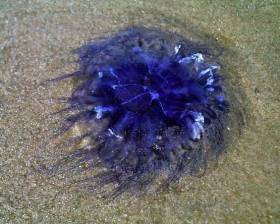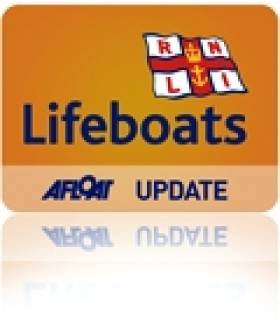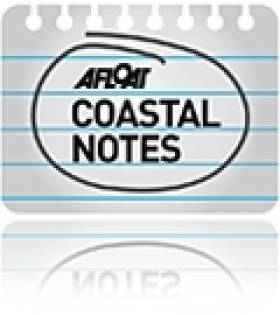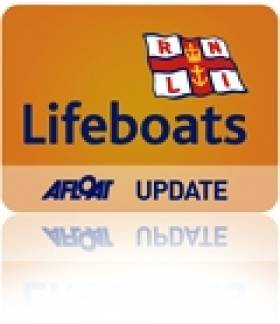Displaying items by tag: Sandycove
Jellyfish Warning For Sandycove Beachgoers
#Jellyfish - Dún Laoghaire-Rathdown County Council has raised the red warning flag in Sandycove and erected signs warning swimmers of the presence of stinging jellyfish in the water and washed up on the beach. Photographs have been taken and sent off for expert identification of the marine species.
#FortyFoot - It's grim news for the Forty Foot's swimming club as members agreed this week to put its future up to vote.
The Irish Times reports on Thursday night's (27 November) extraordinary general meeting held in the wake of the Sandycove Bathers' Association's loss of insurance cover.
That came after a €7,000 settlement over a claim made against the club and Dun Laoghaire-Rathdown County Council by a member of the public, as covered previously on Afloat.ie.
The claim clouded a situation already made bleak by a substantial insurance payout in 2004 to a non-club-member who suffered serious injuries while diving at the Dublin Bay swimming hole made famous in James Joyce's Ulysses.
And the potential future exposure of the club's members to litigation has prompted a vote on disbanding and dropping their lease on the Forty Foot when they reconvene in two weeks' time.
The Irish Times has more on the story HERE.
Forty Foot Bathing Club's Future Up For Vote At EGM
#FortyFoot - The Sandycove Bathers' Association will hold an EGM this Thursday 27 November on its future at the famous Forty Foot after its insurer withdrew cover.
According to The Irish Times this morning, the club announced in a letter to members that its insurer Allianz has withdrawn public liability cover in the wake of a €7,000 settlement after a claim against it and Dun Laoghaire-Rathdown County Council (DLRCoCo).
As a result, the club will now vote on whether it should continue to manage and maintain the popular Dublin Bay swimming spot, which features prominently in James Joyce's Ulysses, and was in the news earlier this year after the club lifted its long-time ban on women members.
If the club does pull out, DLRCoCo says it would take over the Forty Foot and. among other things, open it to public bathing.
The Irish Times has more on the story HERE.
Lifeboat, Helicopter Rescue Swimmer Off Forty Foot In Choppy Water
#dublinbay – A regular swimmer at the popular bathing place in Sandycove, Co. Dublin was hospitalised after being rescued from the sea this morning.
The man had been swimming from the 40-foot shortly after 9am when he encountered difficulties in the choppy seas between the bathing place and Sandycove Harbour.
The Dun Laoghaire RNLI inshore lifeboat was paged by the Irish Coast Guard's Marine Rescue Coordination Centre (MRCC) Dublin at 9.37am and the three volunteer crew launched shortly afterwards.
A second swimmer had reached the casualty with a ringbuoy and was bringing the man towards the rocks when the inshore lifeboat arrived on scene. The man was carried ashore and treated for hypothermia and minor injuries by the lifeboat crew.
The second swimmer was checked by the Dun Laoghaire Coast Guard Unit and was unhurt.
A HSE ambulance was despatched to the scene and a decision was made to MEDEVAC the casualty to the Irish Coast Guard Rescue 116 helicopter due to his deteriorating condition.
Dangerous Jellyfish Removed From Dublin Beach
#Jellyfish - The Irish Mirror reported on Friday that 17 dangerous lion's mane jellyfish were removed from Sandycove Beach on south Dublin Bay.
However, that may be just the tip of the iceberg in their numbers as the giant venomous species flocks to Ireland's warming coastal waters from elsewhere in the Irish Sea.
Meanwhile, restrictions on bathing have been lifted from nearby Sandycove Harbour and Killiney Beach after elevated bacterial levels were detected in the water earlier in the week.
Dollymount Strand's temporary bathing ban has also been lifted, as have a number of advisories in North Co Dublin.
However, precautionary notices remain at three locations – Burrow in Sutton, Claremont in Howth and Loughshinny Beach between Rush and Skerries – due to poor results of samples collected from outfalls at those locations.
Sandycove Harbour Gets Funding Boost in Budget '14 Allocation
#Harbours - Sandycove Harbour will receive more than €50,000 from a €295,000 package for repairs and upgrades to piers, quays and harbours around the Irish coast, as South County Dublin LifeTimes reports.
The funding forms part of the €10 million allocation in last month's Budget to maintain the infrastructure of the State's fishery harbours, as previously announced by Marine Minister Simon Coveney.
Covering 75% of the anticipated €70,000 cost of remedial works at Sandycove Harbour, the new funding follows similar improvements announced for nearby Dun Laoghaire, which is set to get its own 'urban beach' along the lines of Berlin's Badeschiff.
Sandycove Harbour and its adjacent beach on the south side of Dublin Bay are used all year round, with the famous Forty Foot swimming spot at the back of the beach attracting hardy souls even in the depths of winter.
Easy Swim at Forty Foot on Warmest Christmas Day in Years
#WEATHER - Those hardy Yuletide bathers at the Forty Foot in Dublin didn't need to be so brave this year, as Ireland experienced one of the warmest Christmas Days on record.
Just one year ago Ireland was in the grip of a deep freeze. But as the Irish Independent reports, temperatures on Sunday last rose to as much as 14.4 degrees in Co Cork.
It's been almost a decade since late December temperatures reached such levels, when Christmas in 2002 saw highs of 14.6 degrees according to Met Éireann records.
Sunny spells on the east coast brought out the polar bear plungers to Sandymount and the Grand Canal as well as the famous Forty Foot bathing spot in Sandycove.
The Irish Independent has more on the story HERE.
Lifeboat Launches for Swimmer in Difficulty on Dublin Bay
A swimmer in difficulty was brought to safety at lunchtime today by the RNLI inshore lifeboat from Dun Laoghaire when a large swell caused problems at the popular 40-foot bathing-place at Sandycove, Co. Dublin.
The incident occurred when the female swimmer was unable to get ashore because of a breaking swell along the rocky shoreline. A male swimmer entered the water with a life-ring and supported the casualty while a member of the public telephoned 999 and asked for Marine Rescue.
The Irish Coastguard Marine Rescue Co-ordination Centre (MRCC) at Dublin received the alert and tasked the RNLI inshore lifeboat (ILB) at Dun Laoghaire shortly after 12.30pm. The volunteer crew of three launched seven
minutes later and recovered both swimmers from the water and landed them at Sandycove Harbour. A third swimmer was able to make his own way ashore and did not require assistance.
Weather conditions were fine with almost no wind but a sea-swell left-over from the near gale force winds last night combined with a flooding spring tide made swimming conditions more difficulty than usual. All three swimmers were reported to daily-regulars. None needed medical attention.
The ILB at Dun Laoghaire is an IB1-type that was recently placed on station and will be officially dedicated next year. The fully-inflatable boat is faster than its predecessor delivering a top speed of 25 knots and is ideal for reaching casualties close to rocks or shallow areas.
The crew of the ILB was Gary Hayes (Helmsman) Dan O'Sullivan and Sean Shanahan.
Related Safety posts
RNLI Lifeboats in Ireland
Safety News
Rescue News from RNLI Lifeboats in Ireland
Coast Guard News from Ireland
Water Safety News from Ireland
Marine Casualty Investigation Board News
Marine Warnings































































